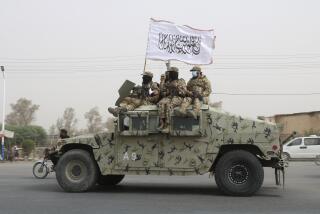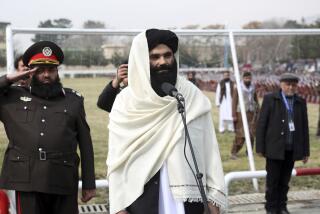Taliban appears on verge of taking over a key district in Afghanistan
The Taliban stood on the verge of gaining an important foothold in southwestern Afghanistan on Tuesday, as additional government troops and British military advisors joined an increasingly desperate attempt to defend the key district of Sangin.
Residents there said that large portions of the district have already fallen under Taliban control. “They’ve taken over the main bazaar and the district center,” said Haji Akhtar Mohammad.
He said the fighting forced him and his family to flee from their home near the district center to the outskirts, and many of their neighbors were trapped in the crossfire.
“We can’t get to the injured and they can’t get to us, we have no idea what condition anyone is in,” he said.
Sangin is part of Helmand, the largest of the country’s 34 provinces in terms of territory and an important gateway to Pakistan and smuggling routes used by local militias to transport arms and drugs. The base of U.S. and British forces until most withdrew in 2014, the province has teetered between government and Taliban control for the last decade.
The Taliban now seems to have the upper hand, by some counts controlling as many as 10 of the 13 districts.
“Helmand would make an important base for their military commanders,” said Borhan Osman, a political analyst in the Afghan capital, Kabul. “It could serve as a launching ground for future endeavors.
“They want to stabilize and secure their control,” he said.
The provincial governor, Mirza Khan Rahimi, sought to downplay any Taliban gains, telling local media on Monday that government troops remained in control of Sangin.
He was responding to a Facebook post a day earlier by the deputy governor, Mohammad Jan Rasoolyar, who warned that a takeover of the district was imminent and that Helmand was at a tipping point.
“I cannot be silent any more,” he wrote. “Helmand stands on the brink.”
Addressing his comments to President Ashraf Ghani, Rasoolyar said that at least 90 government troops had been killed in two days of battles in Sangin and Gereshk districts.
The Defense Ministry denied that death toll but did not offer another figure.
On Monday, Abdullah Abdullah, the president’s chief executive, told the council of ministers, which he chairs, that fresh forces were being sent to Helmand and being strategically deployed. He described the situation there as a priority for his administration.
Sediq Sediqqi, an Interior Ministry spokesman, said Tuesday that fighting between the Taliban and government forces was underway in six districts of Helmand and that at least 12 Taliban militants and two policemen had been killed in the last 24 hours.
He said that on Saturday government troops took back the district of Khanashin, which had fallen to the Taliban 10 days earlier.
“All measures are being taken” to ensure the province does not fall into Taliban hands, he said.
That includes sending 10 British military advisors to Lashkar Gah, Helmand’s capital. They joined 450 British troops that stayed behind in Afghanistan in training and advisory capacity after last year’s withdrawal of international combat forces.
The Taliban has been gaining strength in recent months. This fall, its forces captured the city of Kunduz, the first time since the U.S.-led invasion in 2001 that the group had taken over a major urban center.
The fighting there and elsewhere has taken a heavy toll on the Afghan population, with an estimated 200,000 fleeing the country this year alone.
Despite reports that some Taliban fighters come from Pakistan and Iran, residents of Sangin said the militants appeared to be local. “They came from the area,” Mohammad said. “So far I’ve only seen Afghans.”
Nicholas Haysom, the United Nations envoy to Afghanistan, told the Security Council on Monday that there has been an “overall deterioration” in the country’s security situation.
Gen. Joseph F. Dunford Jr., chairman of the U.S. Joint Chiefs of Staff, put it more bluntly in a recent interview with the military newspaper Stars and Stripes. “I still call it a war — there’s still a war in Afghanistan,” he said.
Latifi is a special correspondent.
More to Read
Start your day right
Sign up for Essential California for news, features and recommendations from the L.A. Times and beyond in your inbox six days a week.
You may occasionally receive promotional content from the Los Angeles Times.






